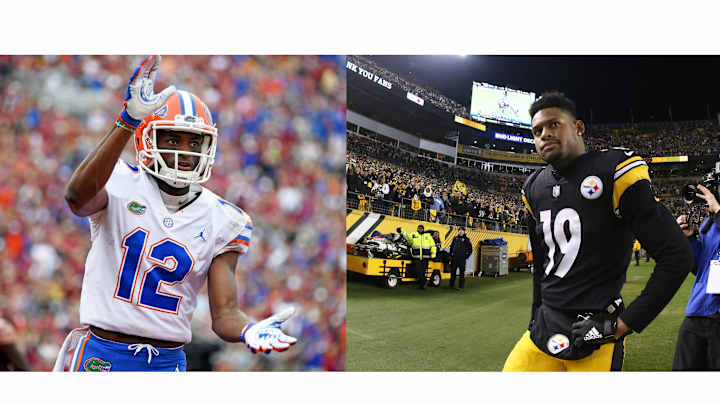Comparing Florida's wide receivers to NFL wide receivers

This idea came to me when Florida Gators wide receiver Van Jefferson told me he specifically studies the games of Los Angeles Chargers WR Keenan Allen and Atlanta Falcons WR Calvin Ridley, in order to perfect his craft.
It's obvious that the Gators are loaded with talent at wide receiver, but exactly what kind of talent do they have in the room? What does each player do best?
Here are the best NFL wide receiver comparisons I could think of for four Florida Gators receivers. If you have any other comparisons, make sure to leave a comment below!
Van Jefferson: Juju Smith-Schuster, Pittsburgh Steelers
Jefferson led the Gators in all important receiving categories during the 2018 season, much like Smith-Schuster is projected to in Pittsburgh following the departure of Antonio Brown.
When attempting to find a comparison for Jefferson, I searched for a polished route runner with plus lengthed paired with solid, but average, athleticism. Smith-Schuster runs a 4.54 40-yard dash, standing at 6-1, 215 lbs., with nearly 33" arms.
Compare those numbers to Jefferson's reported 4.56 40-yard dash, while standing at 6-2, 197 lbs., and clearly lengthy arms that aren't measured on record. Physically, Smith-Schuster and Jefferson are awfully similar.
Both players are technicians within their routes, which elevates their game beyond average athleticism. They have a clear understanding of zones through defenses and how to find openings, utilizing precise footwork to separate from off-defenders. Both have some work to do beating press coverage jams with their hands, but they make up for that with the ability to contest balls at the boundary.
Trevon Grimes: Kenny Golladay, Detroit Lions
This is Trevon Grimes' NFL comparison for now, but his path splits in two this season - which direction will he go?
If his route-running improves as well as it's projected to in 2019, it will change to a more dominant player - perhaps Mike Evans. Rather, if he continues to polish his presence as a red-zone weapon, boundary player, and a dominant player on the vertical stem, he'd remain Kenny Golladay. The really good version of Kenny Golladay.
- Grimes: 6-5, 214 lbs., lengthy arms, 4.47 40 time, 33 3/4" vertical jump
- Golladay: 6-4, 218 lbs., 32' arms, 4.5 40 time, 35 1/2" vertical jump
- Evans: 6-4 3/4, 231 lbs, 35 1/8" arms, 4.53 40 time, 37" vertical jump
Grimes posted a productive sophomore campaign, ranking third on the team in receptions (26) and yards (364), and fourth in yards per catch (14) among receivers with at least 10 receptions. This was immediately following his transfer from Ohio State, so his transition to a new offense took time but worked out well.
Golladay had a breakout season in 2018, hauling in 70 receptions for 1063 yards, five touchdowns, and 15.2 yards per catch. This followed a rookie season similar to Grimes' sophomore campaign, where Golladay recorded 28 receptions for 477 yards, three touchdowns, and 17 yards per reception.
The Lions' receiver is well known for his ability to high-point and win contested catch battles - hauling in 56.7% of his contested targets in 2018, ranking seventh in the NFL. Much like Golladay, high-pointing is a calling card for Grimes with his length pairing well with his athleticism.
Evans possesses the same skill-set, which was his calling card back at Texas A&M and when he entered the NFL. However, a switch flipped for Evans during his second season with the Tampa Bay Buccaneers, and his route running drastically improved. Now, Evans is one of the most complete, dynamic receivers in the NFL.
So which way will Trevon Grimes go?
Josh Hammond: Tyler Lockett, Seattle Seahawks
Talk about Mr. Dependable.
Hammond doesn't drop the ball - literally. Pro Football Focus has Hammond tied for first with a drop rate of 0.0% among returning SEC WRs with a minimum of 35 targets. Van Jefferson wasn't far behind, coming in fourth at 2.8%.
Lockett, like Hammond, is a sure-handed receiver - he didn't drop a single target in 2018, and he was targeted 70 times.
Both players are best out of the slot and running underneath routes, beating linebackers with burst and polished technique to separate. Lockett's athleticism makes him elusive after the catch, which helped lead to his 16.9 yards per catch in 2018. Hammond's 13.2 yards per catch is nice for a short-field receiver as well, but he fights for yards with physicality and a slightly bigger build compared to Lockett's speed.
The cherry on top: Both Lockett and Hammond are willing run-blockers. That's crucial for any Hammond comparison, as he's Florida's best and most willing run-blocking receiver.
- Hammond: 6-0, 194 lbs., 4.27 20 yard shuttle (tests short-distance burst and agility), no 40-yard dash on record
- Lockett: 5-10, 182 lbs., 4.07 20 yard shuttle, 4.4 40-yard dash
Kadarius Toney: Kendall Wright, former Tennessee Titans first-round pick
I had to dig into the archives a bit to make a comparison to Kadarius Toney. The common comparison for Toney is Percy Harvin among Florida fans, and while that makes sense due to their electricity with the ball in their hands, I think the comparison as a whole is a little off.
The 5-11, 194 lb. Toney isn't the fastest player on the field in a straight line, as he was clocked 4.69 40 yard dash. What makes Toney special is his elite burst in the short field and in traffic... Harvin was special in both respects, as well as a more complete receiver in terms of his routes, ability to separate, and hands.
Wright, with a frame similar to Toney at 5-10 1/4, 196 lbs., didn't have the juice to be a burner down the field. However, Wright was explosive in the short-field and congested areas. He ran a 4.61 40-yard dash which is in the 17th percentile among NFL WRs, but his 1.53 10-yard split ranks in the 68th.
Toney doesn't have a 10-yard split on record, but from studying his tape it's clear that he'd perform well in the drill.
While neither players have legitimate cases to be a team's true No. 1 receiver, their elusiveness and burst make them incredibly valuable complementary pieces to a fast-paced offense. When the ball is in their hands, good luck trying to take them down.
